| |
|
|
|
|
English Family Quick Links
|
|
|
|

|
|
|
|
|
Family 28: Place's White Turk Mare
 |
VIEW DESCENT CHART
This family was developed at the Grimsthorpe, Lincolnshire, stud of Robert Bertie, the fourth Earl of Lindsey (1701), Marquis of Lindsey (1706) and first Duke of Ancaster (1716), and his son, Peregrine Bertie, the second Duke. The stud book (1719-1737) of the second Duke's was unearthed in the 1930s, and published by C.M. Prior in his book, Early Records of the Thoroughbred Horse (London: The Sportsman Office, 1924). Its information necessitates some adjustment to the General Stud Book for this family, particularly in regard to the mare Romp (1736 by Lord Walpole's Turk), whom the General Stud Book assigns to this family, whereas the Ancaster stud book shows her to be a descendant of the Oldfield mare (Family 14).
This family has its roots, according to the General Stud Book, with a mare by Place's White Turk, a horse imported into England in 1657. According to the GSB, this mare produced a daughter, called the (Duke of Somerset's) Coppin Mare, both in the GSB and the Ancaster stud book, by the Selaby Turk. Since a horse known as the Selaby Turk, who was siring horses around and after 1700, was imported into England in 1699 by Richard Marshall, Master of the Royal Stud, there is clearly a discrepancy in the pedigree. Prior proposes that the Turk in this pedigree was an earlier importation belonging to Marshall's older brother, master of the Selaby estate.
The Coppin mare produced a daughter by Old Commoner, the only foal of hers noted in the GSB, and the pedigree is confirmed in the Ancaster stud book, where the daughter is called "Ye Somerset Mare." This mare was producing foals starting around 1709 in the Ancaster stud. According to the GSB, she was bred by John Croft of Barforth, Yorkshire, who was closely allied with the D'Arcy family of Sedbury, but since she was out of the Duke of Somerset's Coppin Mare, and she herself was referred to as the Somerset Mare in the Ancaster Stud, it's likely the mare belonged to Somerset, and may have been lodged at Croft's stud. The Somerset Mare had made her way into the Ancaster stud by 1709 or so, when her first foal there is recorded in the Ancaster stud book. It is from this mare that the family branches out, all of her foals retained in the Ancaster stud, according to the stud book.
The General Stud book notes that the Coppin Mare is confused in old pedigrees with "The Coffin Mare (a mare so called by being concealed by Mr Place in a cellar in Fenchurch Street, at the time of the Restoration, which was probably her grandam)." This does, at least, raise the question as to whether the Coppin mare shown in the Ancaster stud book as dam of the Somerset Mare ("out of ye Coppin Mare, and got by Old Commoner") was perhaps the second or third generation of mares known as the Coppin or Coffin mare, given the tendency of seventeenth century breeders to identify daughters in the same manner as their dams, and that the Place's White Turk mare was perhaps her grandam, rather than her dam.
|
Place's White Turk Mare's
Known Produce:
Coppin Mare (f) by Selaby Turk. Dam of
Somerset Mare (f) by (Old) Commoner. Dam of
Governor (c, c. 1709) by St. Martin
Pudding Mare (f) by St. Martin. Dam of
Sweetlips Mare (f) by (Ancaster) Merlin
Rusty Mare (f) by (Ancaster) Merlin
Greathead (c, 1711) by Ely Turk
Virgin (f, 1712) by (Ancaster) Merlin. Dam of
Junquil (c, 1719) by (Old) Pert
Miss Hip (f, 1722) by Oysterfoot
Unnamed (c, 1723) by Alcock's Arabian
Mare (f, 1725) by Sutton's Arabian
Unnamed (c, 1730) by (Ancaster) Ball
Grey Ward (c, 1738) by (Old) Crab
Mare (f, 1733) by Wynn's Arabian
Darling Mare (f) by (Ancaster) Merlin. Dam of
Turnstall Mare (f) by Ely Turk
Venus (f, 1721) by (Ancaster) Merlin |
|
|
FAMILY #28 NOTABLE DESCENDANTS
|
|
Family #28 Oaks Winners
|
|
|
|
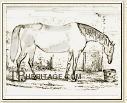 |
|
Wings |
|
1825 WINGS ch.f. 1822
(The Flyer - Oleander) |
| |
Family #28 Derby Winners
|
|
|
|
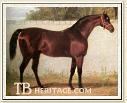 |
|
Emilius |
|
1823 EMILIUS b.c. 1820
(Orville - Emily) |
|
|
Family #28 St. Leger Winners
|
|
|
|
|
Family #28 Other Family Members
|
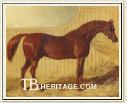 |
| Actaeon |
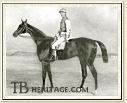 |
| Barbillon |
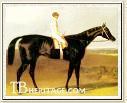 |
| Caravan |
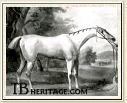 |
| Grey Diomed |
|
Actaeon ch. c. 1822
(Scud - Diana)
A better race horse as he aged, and at longer distances, he placed second in a small sweep, his only hit in six starts at age 3, including the Derby and St. Leger. At age 3 he won the Great Subscription Purse (2 miles), beating Memnon, and the second Great Subscription Purse, beating Mulatto, and one other race, placing second in the Doncaster Stakes. At age 4 he won the Gold Cup at Richmond, a drop in class, and placed in several other races, and at age 5 he won the four mile King's Guineas race during the Caledonian Hunt. His best offspring was General Chasse. |
Barbillon b.c. 1869
(Pretty Boy - Scozzane)
Top stayer in France, he won the Prix Royal Oak (French St. Leger) and the Prix Gladiateur (3200 m.), placed second to Cremorne in the Grand Prix de Paris. Owned by the Duke of Hamilton, later bred to the Duke's mares, he established a fair line of race mares when bred to another of the Duke's horses, Little Agnes (second, Prix du Jockey Club, 1872). His daughter, Black Agnes, was dam of Duncan, winner of the Hungarian St. Leger in 1893. |
Caravan b.c. 1834
(Camel - Wings)
One of two good sons of Oaks winner Wings, Caravan ran second in his first race, the Derby Stakes, to Phosphorus. He later won the Ascot Gold Cup (1839). |
Chouberski b.c. 1902
(Gardefeu - Campanule)
Ran one race in France, and broke down; became the principal conduit of the Byerley Turk sire line through son Bruleur, a top racehorse who won the Grand Prix de Paris and the French St. Leger and sire of four French Derby winners. Chouberski also got La Bidouze, dam of Biribi, a significant French sire, and a number of other good broodmares. |
Emilius b. c. 1820
(Orville - Emily)
Orville's best son, he won the Derby and six other races at age 3, including the Grand Duke Michael Stakes and the Riddlesworth Stakes; at age 4 he won one match race, and then was sold and retired to stud at Riddlesworth, where he sired racehorse (dead-heated for St. Leger) and sire Euclid; Plenipotentiary (Craven Stakes, Derby); Priam (Derby, Craven Stakes, Goodwood Cup and others), twice leading sire in England and four times leading sire in the U.S. after his export there. |
Grey Diomed gr. c. 1785
(Diomed - Grey Dorimant)
Good racehorse ran for five years, winning the Claret Stakes, the Jockey Club Plate, and a 1400 Guineas subscription purse at Newmarket, among others. He was sold to Russia, where he ran "with success." |
Saxon br. c. 1871
(Beadsman - Girasol)
Winner of the Belmont Stakes in 1874, he was imported into the U.S. with his dam, Girasol, by Pierre Lorillard. Sired the undefeated three year old filly Hiawasse, and also got Gerald, another good racehorse. |
Wings ch.f. 1822
(The Flyer - Oleander)
Her dam was sister to the dam of Emilius; she was bred at the Grosvenor stud. A very good race mare for Grosvenor, she won the Epsom Gold Cup at age three, and two days later won the Oaks, ridden by top jockey Sam Chifney, and followed that by winning the Stamford Gold Cup. At age four she won the King's Plate for Mares at Newmarket spring, the Burghley Stakes at Stamford, and beat Escape in a match at Newmarket Houghton meet. She was retired to the royal stud at Hampton Court, and produced two good winners, Caravan, and French 2,000 Guineas winner Fiammetta, but no daughters that bred on successfully. |
|
|
|
|
|
|
|

